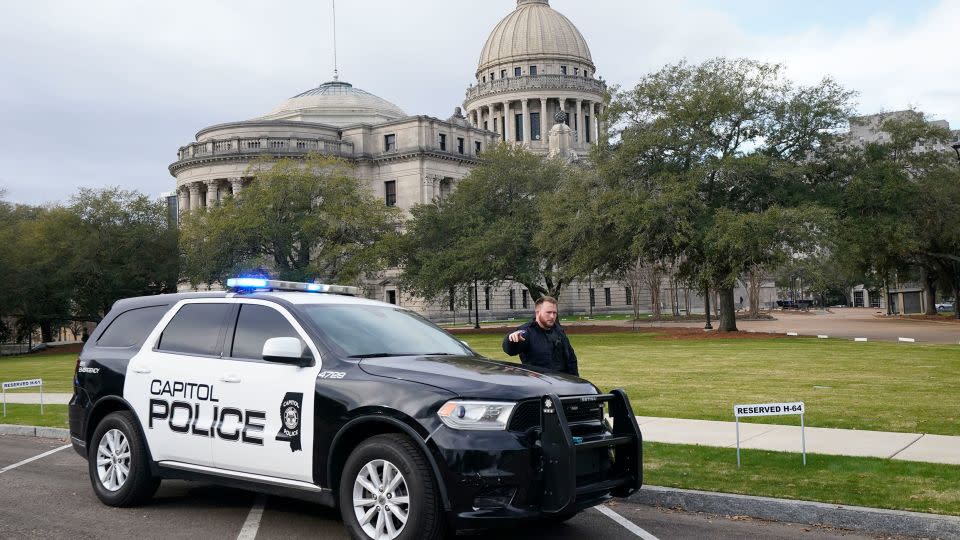High-profile political figures are the targets in the latest wave of ‘swatting’ incidents. Why the trend is so alarming
- Oops!Something went wrong.Please try again later.
The emergency police dispatch went out just before 10 p.m.: Gunfire reported at the Washington, DC, home of a prominent federal official.
A male caller said he shot his girlfriend and threatened to kill himself, according to a source familiar with the incident last Sunday.
With claims of a gunshot victim and a potentially barricaded suspect, DC metropolitan police launched officers to the residence and the city’s fire department began dispatching multiple rescue teams.
Eleven minutes later, the clipped, agitated voice of a firefighter on the scene came across the radio, instructing dispatchers to immediately halt all inbound resources.
“We’ve thoroughly searched the area with (police),” the first responder reported. “We find nothing. Return all units.”
According to a police report, an unidentified woman at the residence told officers she was alone and uninjured.
The home belonged to Tanya Chutkan, the federal judge overseeing the election subversion case against former President Donald Trump. She is just one of the latest high-profile victims in a new wave of “swatting” incidents occurring during an election season security experts fear will be marked by increased intimidation and violence.

‘Toxic mix for misunderstanding and danger’
Swatting is a dangerous criminal hoax where a false report is made to police with the express purpose of luring them to a location, where they are led to believe a horrific crime such as a mass shooting, an imminent bombing, or hostage taking has been committed or is in progress.
This can result in a forceful response from local police and SWAT teams, who have no way to know the call is a hoax.
Swatting has been on the FBI’s radar for nearly two decades, and gained notoriety after high-profile celebrities like Ashton Kutcher, Justin Bieber and Kim Kardashian became victims. In a 2008 assessment of the “new phenomenon,” the FBI said a group of recently convicted swatters were motivated by “bragging rights and ego, versus any monetary gain,” noting group members “did it because they could.”
Over time, law enforcement analysts studying incidents of swatting have observed an expanded list of motivations, including personal or societal grievances, disrupting operations at schools and places of business, diverting law enforcement resources away from other crimes, and financial gain.
And what started as a way for mischief-making video gamers to commit pranks has, in recent months, resulted in numerous high-profile political victims.
The troubling trend even reached the White House on Monday, when a call was placed to 911 falsely claiming there had been a fire and someone was trapped inside, a source familiar with the incident told CNN.
Multiple fire and EMS units were dispatched to the White House following the call at 7:03 a.m., which was traced to a fake number, the source said.
The call was quickly determined to be a false alarm resulting from a swatting incident and an “all clear” was heard on dispatch radio at 7:15 a.m.
President Joe Biden spent the weekend at Camp David and wasn’t at the White House at the time. The US Secret Service declined to comment, directing questions to DC Fire and EMS. CNN has reached out to the department for comment.
On Thursday morning, Nassau County police in New York rushed to the home of Judge Arthur Engoron in response to a bomb threat on the same day he was presiding over closing arguments in the $370 million civil fraud trial against Trump. Investigators said they were treating it as a swatting incident, and deemed it an unfounded threat.
Last week, Capitol buildings in multiple states were temporarily shut and evacuated because of threats claiming explosives had been placed inside.
“We have a tendency to view these swatting incidents as not really ‘real’ because, by definition, they are a hoax, but there is nothing funny or pretend about them,” said CNN Senior National Security Analyst Juliette Kayyem, who specializes in threat management.
“Rapidly responding police officers coming upon a startled bystander who is totally unaware of what is happening is a toxic mix for misunderstanding and danger.”
The results of swatting have indeed been deadly.
In 2017, Andrew Finch was killed by police after a group of online gamers — later imprisoned — took part in calling 911 to report a man at his residence shot his father in the head, and was holding his mother and brother at gunpoint, threatening to set the home ablaze.
Finch came out of the house when police arrived and was shot, according to the US attorney, when he dropped his hands as officers were telling him to raise his arms.

‘An old technique using modern technology’
While prank calls and fake threats are as old as telecommunication, the relative anonymity afforded by the internet has often frustrated the ability of law enforcement to geographically pinpoint bad actors who are causing panic and fear.
According to law enforcement intelligence analysts, sophisticated techniques used by swatters have included calls placed online using Voice over Internet Protocol (VoIP) services, so-called virtual private networks that can mask a user’s unique address, as well as the use of multiple internet routers to help obfuscate the origin of the call.
Some swatters also have employed artificial intelligence to alter a caller’s voice.
An analysis by the Washington Post of fake threats to hundreds of schools last year found incidents in at least 12 states involved a perpetrator making free calls using a foreign VoIP service.
“It is an old technique using modern technology,” said Oren Segal, vice president of the Center on Extremism at the Anti-Defamation League, who spoke with CNN following threats to more than 400 US Jewish institutions in one weekend alone last month.
More than 30 FBI field offices across the country were involved in investigating those threats, which investigators believe were connected and sent from overseas.
“Online threats are cheaper and easier to mask than any time in human history,” Segal said.
‘Investigate and prosecute’
In response to the recent spate of swatting incidents, law enforcement across the country has stepped up efforts to better share real-time information in hopes of catching perpetrators.
Last year, the FBI launched a “Virtual Command Center” in partnership with state and local authorities, a law enforcement official told CNN. The initiative allows police and intelligence fusion centers to share details of swatting incidents taking place within their jurisdictions, providing authorities nationwide with a “common operating picture” regarding the nature of the threat, and can assist in identifying whether the same perpetrator is responsible for multiple incidents.
Since its inception last May, over 500 swatting incidents have been reported to the initiative, the official said.
Authorities also have increased efforts to help educate first responders on how to determine if an emergency call might be a hoax.
State homeland security analysts in New Jersey, for example, note a call reporting a mass casualty event might be suspicious if it is the only call police have received, compared to the multiple calls typically received following an actual incident.
Analysts say another revealing sign of a potential hoax is if the caller is dialing a nonemergency line to report a threat – since VoIP services often used by swatters do not allow users to dial 911 – and if the caller’s vocal tone and background noise do not match the attack they are claiming to witness.
While online investigations can be extremely difficult, authorities point to another critical avenue of deterrence: arrests.
Last month, the FBI and local police announced the arrest of a juvenile in Southern California, whom authorities say was part of a “swatting ring” responsible for a series of threats “targeting numerous religious, educational, and public institutions in the United States, to include Jewish synagogues and African American churches.”
In May, a 16-year-old was arrested in Florida on suspicion of making a series of false reports of bomb threats at several schools and the Fort Lauderdale-Hollywood International Airport.
National security experts predict the increase in incidents will be met by a ratcheting up of aggressive prosecutions.
“We have to set a baseline of acceptable conduct,” Kayyem said. “The only way to stop these is to investigate and prosecute to the full extent of law.”
‘A message to be silent’
The latest wave of swatting incidents targeting high-profile political figures has threat watchers concerned about the impact such a continued campaign of fear will have on those running for office and the public servants responsible for managing free and fair elections.
“What happened to me was designed to send a message to be silent,” Maine Secretary of State Shenna Bellows said in an interview this week with CNN.
State police responded to a swatting call at her home last month, a day after she removed Trump from the state’s 2024 primary ballot in a decision based on the 14th Amendment’s insurrectionist ban.
The Democrat called the swatting of her home and the “non-stop threatening communications” her colleagues have been receiving unacceptable.

“We as a state and we as a nation are better than this,” said Bellows, but noted “those who seek to intimidate through swatting are a tiny minority seeking to sow discord.” She said most Americans “share values in the Constitution and the Bill of Rights. Our laws and our Constitution will carry us through.”
Those sentiments were echoed by former Democratic state senator Adam Morfeld of Nebraska, who told CNN his home was swatted on Christmas morning by a perpetrator who told police Morfeld had just killed his wife and was threatening to kill himself.
“I think it’s meant to silence people and keep them from exercising their constitutional rights and participating in the political sphere,” said Morfeld.
“This is a bipartisan issue,” said Georgia state Sen. Clint Dixon – one of several Republican officials who also have been recent victims of swatting.
Some states, such as Ohio, Virginia and Washington, have recently enacted laws to strengthen the penalties for swatting, but Dixon told CNN swatting should also be made a federal crime.
While authorities have begun adapting to a new type of threat, some elected leaders say the burden should not just be on law enforcement and the criminal justice system, but on those responsible for the toxic political climate.
“There’s something every one of us can do to ensure 2024 is peaceful and protect democracy: de-escalate rhetoric,” Bellows said. “Stop dehumanizing. Have civil, even passionate dialogue with respect and civility.”
CNN’s Dakin Andone, Adam Levine, Jason Hanna, Jamiel Lynch, Artemis Moshtaghian, Melissa Alonso, John Miller, Sabrina Shulman, Betsy Klein and Rene Marsh contributed to this report
For more CNN news and newsletters create an account at CNN.com

